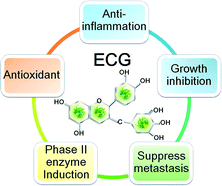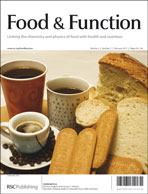The consumption of green tea has long been associated with a reduced risk of cancer development. (−)-Epicatechin-3-gallate (ECG) or (−)-epigallocatechin-3-gallate (EGCG) are the major antioxidative polyphenolic compounds of green tea. They have been shown to exert growth-inhibitory potential of various cancer cells in culture and antitumor activity in vivo models. ECG or EGCG could interact with various molecules like proteins, transcription factors, and enzymes, which block multiple stages of carcinogenesis via regulating intracellular signaling transduction pathways. Moreover, ECG and EGCG possess pharmacological and physiological properties including induction of phase II enzymes, mediation of anti-inflammation response, regulation of cell proliferation and apoptosis effects and prevention of tumor angiogenesis, invasion and metastasis. Numerous review articles have been focused on EGCG, however none have been focused on ECG despite many studies supporting the cancer preventive potential of ECG. To develop ECG as an anticarcinogenic agent, more clear understanding of the cell signaling pathways and the molecular targets responsible for chemopreventive and chemotherapeutic effects are needed. This review summarizes recent research on the ECG-induced cellular signal transduction events which implicate in cancer management.

You have access to this article
 Please wait while we load your content...
Something went wrong. Try again?
Please wait while we load your content...
Something went wrong. Try again?


 Please wait while we load your content...
Please wait while we load your content...